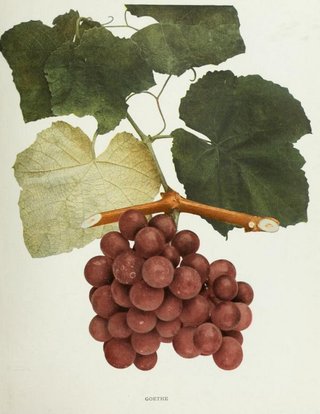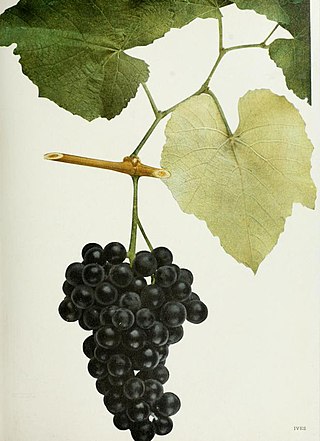
Aurore is a white complex hybrid grape variety produced by French viticulturist Albert Seibel and used for wine production mostly in the United States and Canada. Over a long lifetime, Seibel produced many complex hybrid crosses of Vitis vinifera to American grapes. The Aurore grape is a cross of Seibel 788 and Seibel 29.

Agawam is a hybrid grape variety. It is a crossing of Carter and Muscat Hamburg. Agawam is one of the so-called Rogers' Hybrids created by E.S. Rogers of Salem, Massachusetts, in the early-to-mid-19th century, and is unique among the named cultivars of that group in that it is self-fertile.

Baco blanc or Baco 22A is a French-American hybrid grape variety. It is a cross of Folle blanche and the Noah grape, created in 1898 by the grape breeder François Baco. Folle blanche is its Vitis vinifera parent. Noah, its other parent, is itself a cross of Vitis labrusca and Vitis riparia.

Vitis labrusca, the fox grape, is a species of grapevines belonging to the Vitis genus in the flowering plant family Vitaceae. The vines are native to eastern North America and are the source of many grape cultivars, including Catawba, Concord, Delaware, Isabella, Niagara, and many hybrid grape varieties such as Agawam, Alexander and Onaka. Among the characteristics of this vine species in contrast to the European wine grape Vitis vinifera are its "slip-skin" that allows the skin of the grape berries to easily slip off when squeezed, instead of crushing the pulp, and the presence of tendrils on every node of the cane. Another contrast with European vinifera is the characteristic "foxy" musk of V. labrusca, best known to most people through the Concord grape. This musk is not related to the mammalian fox, but rather to the strong, earthy aromas characteristic of the grapes that were known by early European-American settlers in the New World. The term "foxy" became a sort of catchall for the wine tasting descriptors used for these American wines that were distinct from the familiar flavors of the European viniferous wines.

Hybrid grapes are grape varieties that are the product of a crossing of two or more Vitis species. This is in contrast to crossings between grape varieties of the same species, typically Vitis vinifera, the European grapevine. Hybrid grapes are also referred to as inter-species crossings or "Modern Varieties." Due to their often excellent tolerance to powdery mildew, other fungal diseases, nematodes, and phylloxera, hybrid varieties have, to some extent, become a renewed focus for European breeding programs. The recently developed varieties are examples of newer hybrid grape varieties for European viticulturalists. Several North American breeding programs, such as those at Cornell and the University of Minnesota, focus exclusively on hybrid grapes, with active and successful programs, having created hundreds if not thousands of new varieties.
Rogers' Hybrids are a group of 45 grape seedlings, thirteen of them named as cultivars, developed by Edward Staniford Rogers of Salem, Massachusetts, in the mid-19th century. Although almost entirely gone from cultivation now, their success, along with that of the Concord grape, inspired many amateurs to try grape breeding, resulting in massive proliferation in the number of grape cultivars in the eastern United States and Canada.
Requa is one of the lesser known members of the collection of grape varieties known as Rogers' Hybrids, created by Edward S. Rogers of Salem, Massachusetts in the mid-19th century, and is the result of a cross of Carter, a selection of Vitis labrusca, and Black Hamburg, a selection of Vitis vinifera. It was originally known as Rogers No. 28, until Rogers named it after a James Augustus Requa, agent for Thomas Lake Harris' utopian winegrowing community of 'Salem-on-Erie' at Brocton, New York. Requa is female, and thus requires a second grape variety as a pollen source. Fruit is a dark red, ripens late, and is prone to rot.

Goethe is one of the collection of grape varieties known as Rogers' Hybrids, created by Edward Staniford Rogers of Salem, Massachusetts, in the mid-19th century, and is the result of a cross of Carter, a selection of Vitis labrusca, and Black Hamburg, a selection of Vitis vinifera. It was originally known as Rogers No. 1, until Rogers named it after Johann Wolfgang Goethe, the German author, artist, and scientist.

Black Muscat is a red Vitis vinifera grape variety derived from the crossing of the Schiava Grossa and Muscat of Alexandria by Seward Snow, Head Gardener to Earl de Grey at Wrest Park, Bedfordshire UK in 1850, according to the Vitis International Variety Catalogue. It is known under a variety of local names such as Golden Hamburg, and Black Hamburg in the US; Muscat de Hambourg in France; Moscato di Amburgo in Italy; and Muscat Gamburgskiy in Russia and former Soviet Union countries. Confusingly, Black Hamburg is also used as a synonym for its maternal parent. It is commonly produced as table wine but in California's Central Valley it has been used in the production of dessert wine. As a dessert wine it can be highly aromatic with a rich coloring. In the US it is grown in wine appellations in California, Virginia, Oregon, Texas, and Washington. In Canada, it is also found on Vancouver Island.

Massasoit is one of the collection of hybrid grape varieties known as Rogers' Hybrids, created by E.S. Rogers of Salem, Massachusetts, in the mid-19th century, and is the result of a cross of Carter, a selection of Vitis labrusca, and Black Hamburg, a selection of Vitis vinifera. It was originally known as Rogers No. 3, but in 1869 Rogers named it after a prominent Native American chief from early Massachusetts history, Ousamequin, who used the title Massasoit.
Bouchalès or Grapput is a red French wine grape variety that is grown primarily in Bordeaux and Southwest France wine appellations. Plantings have declined in recent years as the vine has shown high sensitivity to downy mildew and black rot.

Aramon or Aramon noir is a variety of red wine grape grown primarily in Languedoc-Roussillon in southern France. Between the late 19th century and the 1960s, it was France's most grown grape variety, but plantings of Aramon have been in continuous decline since the mid-20th century. Aramon has also been grown in Algeria, Argentina and Chile but nowhere else did it ever reach the popularity it used to have in the south of France.
Couderc noir is a red wine hybrid grape that was formerly grown primarily in the South West France wine region and around the Gard département in the Languedoc-Roussillon region. The vine produces high yields and ripens late, creating a wine that is deeply colored with a distinct, earthy flavor. Couderc noir is normally used for mass commercial and table wines.

Vitis (grapevine) is a genus of 81 accepted species of vining plants in the flowering plant family Vitaceae. The genus consists of species predominantly from the Northern Hemisphere. It is economically important as the source of grapes, both for direct consumption of the fruit and for fermentation to produce wine. The study and cultivation of grapevines is called viticulture.
Alexander is a spontaneous cross of vines from which the first commercial wines in America were made. It was discovered in 1740 in the neighborhood of Springgettsbury, Philadelphia, in a vineyard where James Alexander, Thomas Penn's gardener, had originally planted cuttings of Vitis vinifera in 1683. It was popularized by the Bartram family at Bartram's Garden, Philadelphia, and widely distributed after the American Revolution by William Bartram.
Black Spanish is a variation of grape that was originally assumed to be a seedling of an American hybrid grape which resulted from the crossing of the American Vitis aestivalis species with that of an unknown Vitis vinifera. The vinifera is suspected to have been the pollen donor.

Olmo grapes are wine and table grape varieties produced by University of California, Davis viticulturist Dr. Harold Olmo. Over the course of his nearly 50-year career, Dr. Olmo bred a wide variety of both grapes by means of both crossing varieties from the same species or creating hybrid grapes from cultivars of different Vitis species.

Ives noir is a red hybrid grape variety that is grown throughout the United States. Named after its propagator, Connecticut wine grower Henry Ives, the grape's pedigree and exact origin are unclear. After Prohibition in the United States, Ives was a popular grape used in the production of sweet port-style wines but saw its plantings steadily decrease throughout the 20th century as the vine's susceptibility to air pollution took its toll.

The propagation of grapevines is an important consideration in commercial viticulture and winemaking. Grapevines, most of which belong to the Vitis vinifera family, produce one crop of fruit each growing season with a limited life span for individual vines. While some centenarian old vine examples of grape varieties exist, most grapevines are between the ages of 10 and 30 years. As vineyard owners seek to replant their vines, a number of techniques are available which may include planting a new cutting that has been selected by either clonal or mass (massal) selection. Vines can also be propagated by grafting a new plant vine upon existing rootstock or by layering one of the canes of an existing vine into the ground next to the vine and severing the connection when the new vine develops its own root system.













